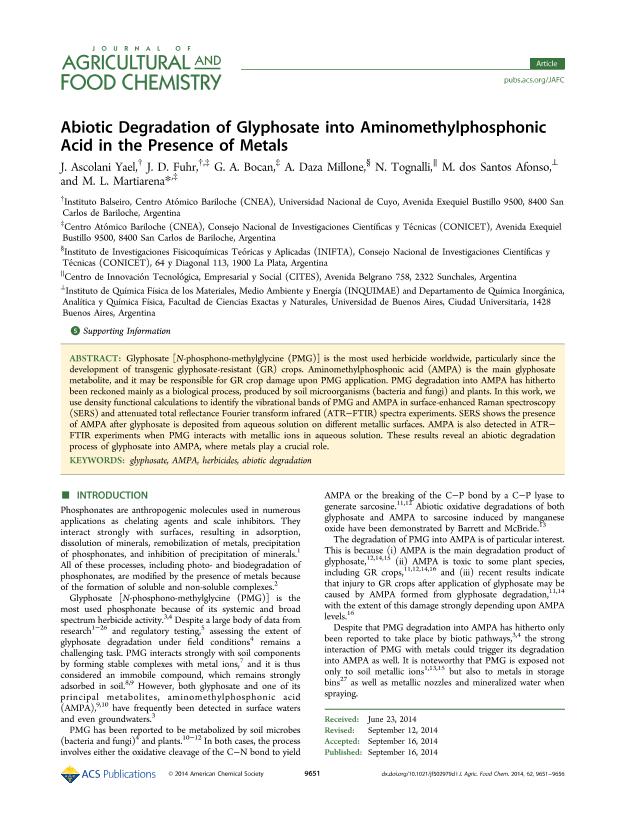Artículo
Abiotic Degradation of Glyphosate into Aminomethylphosphonic Acid in the Presence of Metals
Ascolani Yael, Julian Esteban; Fuhr, Javier Daniel ; Bocan, Gisela Anahí
; Bocan, Gisela Anahí ; Daza Millone, Maria Antonieta
; Daza Millone, Maria Antonieta ; Tognalli, N.; Dos Santos Afonso, María; Martiarena, María Luz
; Tognalli, N.; Dos Santos Afonso, María; Martiarena, María Luz
 ; Bocan, Gisela Anahí
; Bocan, Gisela Anahí ; Daza Millone, Maria Antonieta
; Daza Millone, Maria Antonieta ; Tognalli, N.; Dos Santos Afonso, María; Martiarena, María Luz
; Tognalli, N.; Dos Santos Afonso, María; Martiarena, María Luz
Fecha de publicación:
09/2014
Editorial:
American Chemical Society
Revista:
Journal of Agricultural and Food Chemistry
ISSN:
0021-8561
Idioma:
Inglés
Tipo de recurso:
Artículo publicado
Clasificación temática:
Resumen
Glyphosate [N-phosphono-methylglycine (PMG)] is the most used herbicide worldwide, particularly since the development of transgenic glyphosate-resistant (GR) crops. Aminomethylphosphonic acid (AMPA) is the main glyphosate metabolite, and it may be responsible for GR crop damage upon PMG application. PMG degradation into AMPA has hitherto been reckoned mainly as a biological process, produced by soil microorganisms (bacteria and fungi) and plants. In this work, we use density functional calculations to identify the vibrational bands of PMG and AMPA in surface-enhanced Raman spectroscopy (SERS) and attenuated total reflectance Fourier transform infrared (ATR–FTIR) spectra experiments. SERS shows the presence of AMPA after glyphosate is deposited from aqueous solution on different metallic surfaces. AMPA is also detected in ATR–FTIR experiments when PMG interacts with metallic ions in aqueous solution. These results reveal an abiotic degradation process of glyphosate into AMPA, where metals play a crucial role.
Palabras clave:
Gyphosate
,
Ampa
,
Herbicides
,
Abiotic Degradation
Archivos asociados
Licencia
Identificadores
Colecciones
Articulos(CCT - PATAGONIA NORTE)
Articulos de CTRO.CIENTIFICO TECNOL.CONICET - PATAGONIA NORTE
Articulos de CTRO.CIENTIFICO TECNOL.CONICET - PATAGONIA NORTE
Articulos(INIFTA)
Articulos de INST.DE INV.FISICOQUIMICAS TEORICAS Y APLIC.
Articulos de INST.DE INV.FISICOQUIMICAS TEORICAS Y APLIC.
Articulos(INQUIMAE)
Articulos de INST.D/QUIM FIS D/L MATERIALES MEDIOAMB Y ENERGIA
Articulos de INST.D/QUIM FIS D/L MATERIALES MEDIOAMB Y ENERGIA
Citación
Ascolani Yael, Julian Esteban; Fuhr, Javier Daniel; Bocan, Gisela Anahí; Daza Millone, Maria Antonieta; Tognalli, N.; et al.; Abiotic Degradation of Glyphosate into Aminomethylphosphonic Acid in the Presence of Metals; American Chemical Society; Journal of Agricultural and Food Chemistry; 62; 40; 9-2014; 9651-9656
Compartir
Altmétricas



